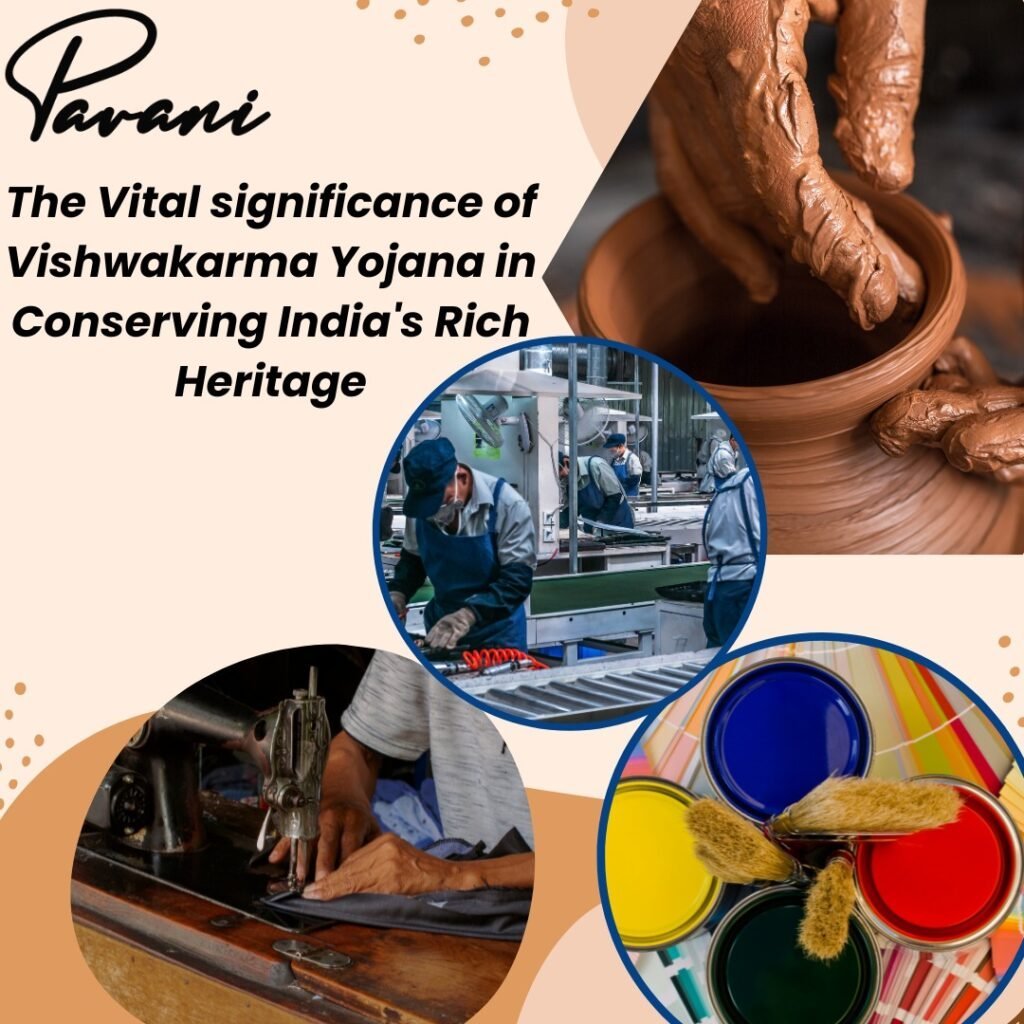The Vishwakarma Yojana is a vital program designed to save India’s rich artistic heritage by reviving traditional artisanal professions. It was launched in 2020 by the Indian government to support tradesmen and craftswomen from marginalized communities who have rehearsed traditional trades for generations.
Through this scheme, tradesmen are handed with coffers similar as access to raw accoutrements , loans, training, marketing, and networking openings to insure the sustainable growth of these occupations. With its focus on furnishing fiscal security and securing the durability of these ancient art forms, the Vishwakarma Yojana is an inestimable action for the preservation of India’s artistic heritage.
1. Understanding the Vishwakarma Yojana Initiative

The Vishwakarma Yojana action is a groundbreaking program that aims to revive and save India’s rich artistic heritage by supporting traditional artisanal professions. Launched in 2020 by the Indian government, this action provides a lifeline to tradesmen and craftswomen from marginalized communities who have been rehearsing traditional trades for generations.
Under the Vishwakarma Yojana scheme, these professed crafters are given access to essential coffers similar as raw accoutrements , loans, training, marketing, and networking openings. This comprehensive support system ensures the sustainable growth and durability of these ancient art forms.
By empowering tradesmen with fiscal security and furnishing them with the means to showcase their chops, the Vishwakarma Yojana action plays a pivotal part in conserving and promoting India’s different artistic heritage. This action recognizes the immense significance of heritage professions in India.
These professions, handed down through generations, embody the country’s traditions, history, and cultural prowess. They reflect the soul of India and contribute to its unique identity on the global stage. still, these heritage professions face multitudinous challenges in ultramodern times.
The arrival of industrialization, globalization, and mass product has posed pitfalls to the survival of these traditional trades. The Vishwakarma Yojana action way in to address these challenges by furnishing tradesmen with the necessary support and coffers to thrive in the face of modernization.
The success stories of the Vishwakarma Yojana action are inspiring and inspiriting. These tradesmen haven’t only revived dying art forms but have also created sustainable livelihoods for themselves and their communities. Their trip is a testament to the transformative power of conserving and nurturing India’s artistic heritage.
2. The Significance of Heritage Professions in India

India is a country rich in history, culture, and traditions, and at the heart of its heritage lies the significance of its heritage professions. These professions, passed down through generations, hold immense significance in conserving India’s different artistic heritage. Heritage professions are further than just livelihoods; they’re a reflection of India’s traditions, history, and cultural prowess.
They embody the soul of India and contribute to its unique identity on the global stage. Whether it’s intricate handloom weaving, delicate crockery, vibrant embroidery, or the professed artificer of wood figure, each profession tells a story and carries the heritage of centuries.
These professions also play a pivotal part in fostering social cohesion and community development. They’re frequently deeply embedded in original communities, with knowledge and chops passed down from elders to youngish generations.
By supporting these heritage professions, the Vishwakarma Yojana action not only ensures the preservation of traditional art forms but also uplifts marginalized communities and promotes social and profitable commission. also, heritage professions hold profitable value as well. They contribute to India’s tourism assiduity, attracting callers from around the world who are fascinated by the country’s rich artistic heritage.
These art forms give employment openings, support original husbandry, and have the eventuality for sustainable growth and development. In summary, the significance of heritage professions in India can not be exaggerated.
They’re the vestments that connect the history with the present and carry forward the artistic heritage of the country. The Vishwakarma Yojana action recognizes this significance and strives to guard and promote these inestimable art forms for unborn generations to appreciate and cherish.
3. Challenges Faced by Heritage Professions in Modern Times

As we claw into the significance of heritage professions in India and the estimable sweats of the Vishwakarma Yojana action in conserving them, it’s pivotal to address the challenges faced by these art forms in ultramodern times. One of the primary challenges faced by heritage professions is the trouble of extermination.
With the arrival of industrialization and mass product, traditional crafts and trades have been overshadowed by robotization and cheap carbons. The youngish generations are frequently drawn to ultramodern professions, leaving behind the ancestral chops and knowledge demanded to sustain these art forms. Without a steady affluence of new interpreters, heritage professions are at threat of fading down.
also, there’s a lack of fiscal support and structure for crafters engaged in these professions. numerous tradesmen struggle to pierce the necessary coffers and requests to show and vend their products. The absence of government programs and impulses frequently leaves them vulnerable to exploitation by mediators and large pots.
likewise, the changing tastes and preferences of consumers pose a challenge to heritage professions. As globalized influences shape the request, traditional crafts may struggle to acclimatize and remain applicable in the eyes of contemporary buyers. This can lead to a decline in demand, farther venturing the survival of these art forms.
In the face of these challenges, the Vishwakarma Yojana action way in to give important- required support and coffers. By addressing these hurdles head- on, the action ensures that heritage professions have a fighting chance at survival and can continue to contribute to India’s rich artistic heritage.
4. Reviving Heritage Professions through Vishwakarma Yojana

The Vishwakarma Yojana action is breathing new life into heritage professions that were formerly at threat of fading down. By furnishing a comprehensive support system, this groundbreaking program is reviving these ancient art forms and icing their sustainability for unborn generations to appreciate and cherish.
Through the Vishwakarma Yojana scheme, tradesmen and craftswomen are given access to essential coffers similar as raw accoutrements , loans, training, marketing, and networking openings. This support empowers crafters to not only save their ancestral chops but also to acclimatize and thrive in the face of modernization.
The action plays a vital part in upping marginalized communities and promoting social and profitable commission. By reviving heritage professions, it provides sustainable livelihoods for tradesmen and creates employment openings for others in their communities. also, the Vishwakarma Yojana action is revitalizing these art forms by fostering a renewed appreciation for traditional crafts.
It’s reconnecting the youngish generations with their artistic roots and breeding a sense of pride in these professions. The success of the Vishwakarma Yojana action is apparent in the remarkable stories of tradesmen who haven’t only revived dying art forms but have also created thriving businesses and converted their communities. Their adaptability and fidelity show the transformative power of conserving and nurturing India’s artistic heritage.
5. Success Stories of the Vishwakarma Yojana Initiative

The success stories of the Vishwakarma Yojana action are nothing short of inspiring. These stories showcase the inconceivable impact that the program has had in reviving heritage professions and transubstantiating the lives of tradesmen and craftswomen. One similar success story is that of Ravi, a professed woodcarver from a small vill in Rajasthan.
Before joining the Vishwakarma Yojana action, Ravi plodded to make ends meet and his traditional craft was on the verge of extermination. still, with the support and coffers handed by the action, Ravi was suitable to ameliorate his chops, access requests, and showcase his beautiful rustic creations. moment, Ravi’s work is sought after by collectors and he has indeed started mentoring youngish crafters in his vill.
also, the story of Shanti, an needleworker from Gujarat, is inversely inspiring. Shanti had always pictured of conserving the traditional embroidery ways of her community, but demanded the coffers to do so. Through the Vishwakarma Yojana action, Shanti entered training, access to requests, and fiscal support.
moment, her intricate exaggerated pieces are celebrated not just in India but also encyclopedically. These success stories are a testament to the transformative power of conserving and nurturing India’s artistic heritage. The Vishwakarma Yojana action isn’t just reviving dying art forms but also creating sustainable livelihoods and upping marginalized communities.
These stories remind us of the inestimable significance of heritage professions and the impact they can have on individual lives and the broader society. Through the Vishwakarma Yojana action, India’s rich artistic heritage is being celebrated and saved for generations to come.
conclusion
The Vishwakarma Yojana action way in to address these challenges by furnishing tradesmen with the necessary support and coffers to thrive in the face of modernization. The Significance of Heritage Professions in India India is a country rich in history, culture, and traditions, and at the heart of its heritage lies the significance of its heritage professions.
Challenges Faced by Heritage Professions in Modern Times As we claw into the significance of heritage professions in India and the estimable sweats of the Vishwakarma Yojana action in conserving them, it’s pivotal to address the challenges faced by these art forms in ultramodern times. These success stories are a testament to the transformative power of conserving and nurturing India’s artistic heritage.
FAQs
How many types of Vishwakarma are there?
The community comprises fivesub-groups — carpenters, blacksmiths, citation smiths, goldsmiths and stonemasons — claim to be descendants of Vishvakarma, the builder and mastermind of heavenly realm, a Hindu deity.
What is the Speciality of Vishwakarma?
Vishwakarma is the presiding deity of all tradesmen and engineers. Son of Brahma, he’s the godly handicraftsman of the whole macrocosm, and the sanctioned builder of all the gods’ palaces.
Also Read : Unraveling the Magic of AI Exploring ChatGPT’s Implici
The Vital significance of Vishwakarma Yojana in Conserving India’s Rich Heritage

